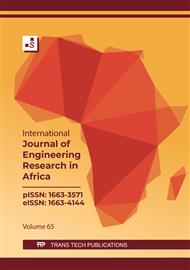[1]
A. Larouci, Y. Senhadji, L. Laoufi, A. Benazzouk, Dredged dam raw sediments geotechnical characterization for beneficial use in road construction. International Journal of Engineering Research in Africa 57(2021), 81-98. Trans Tech Publications Ltd.
DOI: 10.4028/www.scientific.net/jera.57.81
Google Scholar
[2]
T.O. Henderson, A.R. Pickles, Geotechnical management on major infrastructure projects. Proceedings of the Institution of Civil Engineers - Geotechnical Engineering, 157(4)(2004), 165-171.
DOI: 10.1680/geng.2004.157.4.165
Google Scholar
[3]
L. Valenzuela, Tailings dams and hydraulic fills - The 2015 Casagrande lecture. Geotechnical Synergy in Buenos Aires 5(2015), 5-49.
Google Scholar
[4]
H.F. Yonli, B. François, D.Y.K. Toguyeni, A. Pantet, Hydro-mechanical behavior of two clayey soils in presence of household waste leachates. Global Journal of Environmental Science and Management, 8(2) (2022).
Google Scholar
[5]
B. François, L. Palazon, P. Gerard, Structural behaviour of unstabilized rammed earth constructions submitted to hygroscopic conditions. Construction and Building Materials 155 (2017), 164-175.
DOI: 10.1016/j.conbuildmat.2017.08.012
Google Scholar
[6]
K.C. Ezenwaka, A. Ugboaja, C.V. Ahaneku, T.A. Ede, Geotechnical investigation for design and construction of civil infrastructures in parts of port Harcourt City of Rivers State, Southern Nigeria. The International Journal of Engineering Science 3(2014), 74-82.
Google Scholar
[7]
B.M. Das, Principles of geotechnical engineering. Cengage learning, 2021.
Google Scholar
[8]
P.J. Vardanega, M.D. Bolton, Design of geostructural systems. ASCE-ASME Journal of Risk and Uncertainty in Engineering Systems, Part A: Civil Engineering 2(1)(2016), 04015017.
DOI: 10.1061/ajrua6.0000849
Google Scholar
[9]
S. Lacasse, F. Nadim, Risk and reliability in geotechnical engineering. In Int. Conf. on Case Histories in Geotech. Eng (1998).
Google Scholar
[10]
M.P. Kasongo, K.G. Mukoko, M.L. Kipata, I.J.M. Lunda, Elaboration de la carte géotechnique de la ville de Lubumbashi guide technique de sélection des sites d'implantation d'ouvrages du génie civil. European Scientific Journal, 14(2018),407-431. DOI:10.19044/esj.2018. v14n36p407
DOI: 10.19044/esj.2018.v14n36p407
Google Scholar
[11]
NF EN ISO 17892-4, Reconnaissance et essais géotechniques - Essais de laboratoire sur les sols - Partie 4 : Détermination de la distribution granulométrie des particules, AFNOR, 2018.
Google Scholar
[12]
NF 94-051, Sols : Reconnaissances et Essais. Détermination des limites d'Atterberg-limite de liquidité à la coupelle - limite de plasticité au Rouleau. ISSN 0335-3931, AFNOR, 1993.
Google Scholar
[13]
NF 94-068, Sols : Reconnaissances et Essais. Mesure de la capacité d'adsorption de bleu de méthylène d'un sol ou d'un matériaux rocheux par l'essai à la tache - ISSN 0335-3931, AFNOR, 1998.
Google Scholar
[14]
E. Keng, Air and Helium Pycnometer. Powder Technology 3(1970), 179-180.
Google Scholar
[15]
B.A. Mir, Manual of geotechnical laboratory soil testing. CRC Press, 2021.
Google Scholar
[16]
NF P11-300, Exécution des terrassements - Classification des matériaux utilisables dans la construction des remblais et des couches de forme d'infrastructures routières. AFNOR, 1992.
Google Scholar
[17]
ASTM D3080-04, Standard test method for direct shear test of soils under consolidated drained conditions, ASTM, 2013.
DOI: 10.1520/d3080_d3080m
Google Scholar
[18]
ASTM D4767-11, Standard test method for consolidated undrained triaxial compression test for cohesive soils, ASTM, 2020.
DOI: 10.1520/d4767-02
Google Scholar
[19]
J.C. Verbrugge, C. Schroeder, Geotechnical correlations for soils and rocks. John Wiley and Sons, 2018.
Google Scholar


